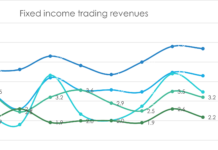The DESK.
Banks will see trading revenue growth fall by roughly 1.5% in 2018 due to MiFID II, and that pressure will sustain for at least a couple of years, according to UBS equity analysts.
In a report entitled: MiFID II’s domino effect: Headwinds likely to impact markets beyond Europe and to last years, the firm’s analysts assessed the likely impact of the regulatory framework upon buy- and sell-side firms, with greater transparency and research unbundling having the largest effect.
Ahead of MiFID II’s 3 January 2018 deadline, underestimation of the incoming changes in the already fragile fixed income sector could make its impact felt beyond 2018. While European firms have had MiFID II in their sights since 2014, UBS notes their US counterparts are less prepared.
The sell-side market in EMEA, which has seen revenues fall by nearly US$30 million since 2010, accounts for approximately 33% of global trading revenues and UBS estimates will be hit by a 1.4% to 2.7% reduction in global trading revenue growth next year and beyond.
“Many firms seem unprepared given the magnitude of change,” the report warned.
Although that reduction is seen as ‘manageable’ the report notes that there is a risk of market disruptions from the rule, “which could roughly double our estimates of regional revenue headwinds.”
They will not be averted by any cuts to expenditure initially to ongoing implementation costs, and firms will be reluctant to change a desire to avoid cuts before the universal is clearer. They will also have to assess their pricing as a way of building market share against driving their profitability. The report identified unbundling of research costs and enhanced trading transparency as key elements that will spill beyond Europe.
Consequences of increased transparency and the impact of caps on dark trading on liquidity are particularly threatening and would create incremental revenue headwinds across Europe.
US bulge bracket firms’ significant presence in Europe could see them experience a decline in trading revenues of 0.5% – 1.5% regionally while data shows Credit Suisse, Deutsche Bank and Barclays are particularly threatened, facing up to 3% annual headwind in securities.
Larger firms could weather the storm more easily; small firms that do not have the resources to absorb costs and help manage MiFID II evolution are likely to feel the impact, with difference in median profit margin potentially reaching over 100bps.
The most disruptive component of MiFID II, research pricing unbundling, hit headlines in September. Following on from competitors’ decisions to fund research themselves, Schroders, Janus Henderson, and Invesco reversed their initial policies. This is apparently the new status quo, and the report said an uptake of research payment accounts is unlikely given current under-performing active management.
Estimated impact of growing research budgets to the buy-side P&L is in between 1 to 3 bps of AUM, however “costs could be higher and impact beyond Europe.”
Unprepared US asset managers may find their institutional clients demand equal treatment to European firms. The cost of research will likely be internalised in the US within five years, resulting in a potential 6% to 14% EPS headwind to the US asset managers.
“Global firms that operate on a single platform will find it operationally complex to limit all the changes to just Europe and the UK,” concludes the report.
©Markets Media Europe 2025












